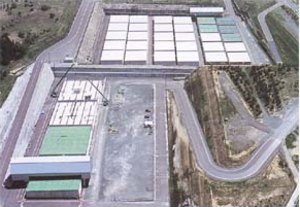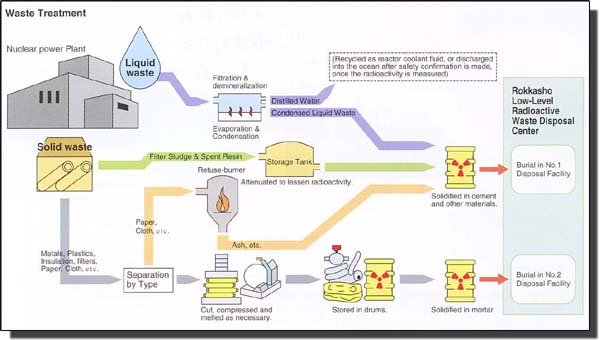The Low Level Radioactivity Wastes(LLW) such as work clothes, gloves, and paper used to clean the nuclear power station floors, they occur with operation and maintenance at nuclear power stations.
At each nuclear power station, a liquid waste is first evaporated and condensed.
The condensed waste is solidified by being mixed with cement or plastic and then is packed into a drum. The flammable waste is burned and packed into the drum.
The inflammable waste such as metal is compressed or melted when possible, and then packed into the drum as well.
It is stored to the nuclear power plants until these waste drums are transported to the LLW disposal center.
Based on the concept of laying underground the LLW that occurred in the nuclear fuel cycle facilities, we plan that the ultimate capacity of the LLW Disposal Center would be 600,000m3 in the future.
The total capacity of 80,000m3(400,000 drums of 200 liters) had already approved to lay underground the LLW. The LLW Disposal center has No.1 and No.2 Disposal facilities in operation which No.1 facility has a capacity of 40,000m3(200,000 drums of 200 liters) and No.2 facility is the same capacity as No.1.
|

Low-Level Radioactive Waste Disposal Center |

The waste packages to be transported are inspected for the surface contamination density, Visual inspection, Dose rate, Radioactivity, Weight, ID No. etc. one by one at the nuclear power plants.
The waste packages that passed inspection are then transported to the LLW Disposal center by ship and truck. |
|

The waste packages carried into the LLW Disposal center are inspected for the visual inspection, ID and RI mark finally in order to confirm the integrity of drums during transportation prior to its final storage. |
|

The waste packages are stacked in the disposal facility. |
|

The spaces between the waste packages are filled with the mortar. |
|
|

A reinforced concrete lid like a monolithic rock is placed atop the disposal facility. |
|

The inspection tunnels are attached to the disposal facility in order to monitor any leakage, leakage condition and to repair the facilities.
Following the establishment of an inspection tunnel, the top and side of the facility are covered with a mixture of water impervious soil and Bentonite(kind of clay) and then the top of it is covered with a layer of soil which planted any grass on the top of the layer.

|
|
|

